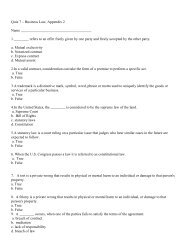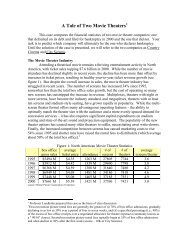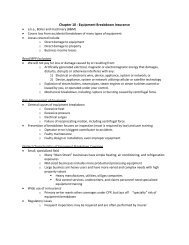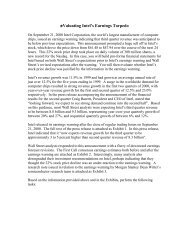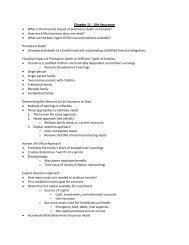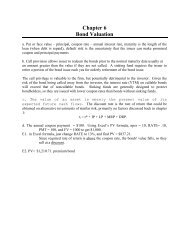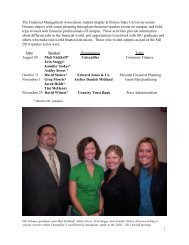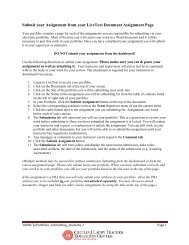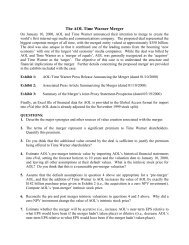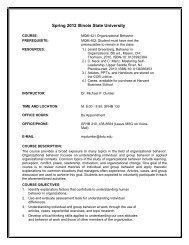In March <strong>1998</strong>, <strong>the</strong> Company issued $150.0 million of 6.75% Senior Notes due 2008 and $150.0 million of 7.25% SeniorDebentures due 2018. The net proceeds to <strong>the</strong> Company were approximately $296.1 million.In March <strong>1998</strong>, <strong>the</strong> Company issued 6,100,690 shares of common stock. The net proceeds to <strong>the</strong> Company were approximately$165.5 million. (See Note 7 -- Shareholders' Equity.)Dur<strong>in</strong>g <strong>the</strong> year ended December 31, <strong>1998</strong>, <strong>the</strong> Company's capital expenditures were approximately $557.0 million as comparedto $1.1 billion dur<strong>in</strong>g 1997 and $722.4 million dur<strong>in</strong>g 1996. The largest portion of capital expenditures related to <strong>the</strong> delivery ofVision of <strong>the</strong> Seas <strong>in</strong> <strong>1998</strong>, delivery of Rhapsody of <strong>the</strong> Seas, Enchantment of <strong>the</strong> Seas and Mercury <strong>in</strong> 1997, delivery ofSplendour of <strong>the</strong> Seas and Grandeur of <strong>the</strong> Seas <strong>in</strong> 1996, as well as progress payments <strong>for</strong> ships under construction dur<strong>in</strong>g <strong>1998</strong>,1997 and 1996. Also <strong>in</strong>cluded <strong>in</strong> capital expenditures are shoreside capital expenditures and costs <strong>for</strong> vessel refurbish<strong>in</strong>g toma<strong>in</strong>ta<strong>in</strong> consistent fleet standards.The Company received proceeds of $94.5 and $100.0 million from <strong>the</strong> sale of vessels dur<strong>in</strong>g <strong>1998</strong> and 1997, respectively.Capitalized <strong>in</strong>terest decreased to $15.0 million <strong>in</strong> <strong>1998</strong>, from $15.8 million <strong>in</strong> 1997 and $15.9 million <strong>in</strong> 1996. The decreasedur<strong>in</strong>g <strong>1998</strong> was due to a reduction <strong>in</strong> <strong>the</strong> level of construction-<strong>in</strong>-progress expenditures associated with <strong>the</strong> Company's fleetexpansion program.Dur<strong>in</strong>g <strong>1998</strong>, <strong>the</strong> Company paid quarterly cash dividends on its common stock total<strong>in</strong>g $55.2 million as well as quarterly cashdividends on its preferred stock, total<strong>in</strong>g $12.5 million. Dur<strong>in</strong>g 1997, <strong>the</strong> Company paid quarterly cash dividends total<strong>in</strong>g $40.8and $9.2 million on its common stock and preferred stock, respectively.The Company made pr<strong>in</strong>cipal payments total<strong>in</strong>g approximately $335.1 and $245.4 million under various term loans and capitalleases dur<strong>in</strong>g <strong>1998</strong> and 1997, respectively.Future CommitmentsThe Company currently has n<strong>in</strong>e ships on order <strong>for</strong> an additional capacity of 21,500 berths. The aggregate contract price of <strong>the</strong>n<strong>in</strong>e ships, which excludes capitalized <strong>in</strong>terest and o<strong>the</strong>r ancillary costs, is approximately $3.6 billion, of which <strong>the</strong> Companydeposited $144.6 million dur<strong>in</strong>g <strong>1998</strong> and $74.3 million dur<strong>in</strong>g 1997. Additional deposits are due prior to <strong>the</strong> dates of delivery of$237.4 million <strong>in</strong> 1999, $88.1 million <strong>in</strong> 2000 and $25.0 million <strong>in</strong> 2001. The Company anticipates that overall capitalexpenditures will be approximately $997, $1,196, and $1,368 million <strong>for</strong> 1999, 2000 and 2001, respectively.The Company has $2.5 billion of long-term debt of which $127.9 million is due dur<strong>in</strong>g <strong>the</strong> twelve month period end<strong>in</strong>gDecember 31, 1999. (See Note 6 -- Long-Term Debt.)In addition, <strong>the</strong> Company cont<strong>in</strong>uously considers potential acquisitions, strategic alliances and adjustments to its fleetcomposition, <strong>in</strong>clud<strong>in</strong>g <strong>the</strong> acquisition or disposition of vessels. If any such acquisitions, strategic alliances and adjustments to itsfleet composition were to occur, <strong>the</strong>y would be f<strong>in</strong>anced through <strong>the</strong> issuance of additional shares of equity securities, by <strong>the</strong><strong>in</strong>currence of additional <strong>in</strong>debtedness or from cash flows from operations.Fund<strong>in</strong>g SourcesAs of December 31, <strong>1998</strong>, <strong>the</strong> Company's liquidity was $1.2 billion consist<strong>in</strong>g of $172.9 million <strong>in</strong> cash and cash equivalents and$1.0 billion available under its $1.0 billion unsecured revolv<strong>in</strong>g credit facility (<strong>the</strong> "$1 Billion Revolv<strong>in</strong>g Credit Facility"). Thecapital expenditures and scheduled debt payments will be funded through a comb<strong>in</strong>ation of cash flows provided by operations,drawdowns under <strong>the</strong> $1 Billion Revolv<strong>in</strong>g Credit Facility, and sales of securities <strong>in</strong> private or public securities markets. Inaddition, <strong>the</strong> agreements related to <strong>the</strong> ships scheduled <strong>for</strong> delivery subsequent to 1999 require <strong>the</strong> shipyards to make availableexport f<strong>in</strong>anc<strong>in</strong>g <strong>for</strong> up to 80% of <strong>the</strong> contract price of <strong>the</strong> vessels.The Company's cash management practice is to utilize excess cash to reduce outstand<strong>in</strong>g balances on <strong>the</strong> $1 Billion Revolv<strong>in</strong>gCredit Facility, and to <strong>the</strong> extent <strong>the</strong> cash balances exceed <strong>the</strong> amounts drawn under <strong>the</strong> $1 Billion Revolv<strong>in</strong>g Credit Facility, <strong>the</strong>Company <strong>in</strong>vests <strong>in</strong> short-term securities.O<strong>the</strong>rThe Company enters <strong>in</strong>to <strong>in</strong>terest rate swap agreements to manage <strong>in</strong>terest costs as part of its liability risk management program.The differential <strong>in</strong> <strong>in</strong>terest rates to be paid or received under <strong>the</strong>se agreements is recognized <strong>in</strong> <strong>in</strong>come as part of <strong>in</strong>terest expenseover <strong>the</strong> life of <strong>the</strong> contracts. The objective of <strong>the</strong> program is to modify <strong>the</strong> Company's exposure to <strong>in</strong>terest rate movements. TheCompany cont<strong>in</strong>uously evaluates its debt portfolio, <strong>in</strong>clud<strong>in</strong>g its <strong>in</strong>terest rate swap agreements, and makes periodic adjustmentsto <strong>the</strong> mix of fixed rate and float<strong>in</strong>g rate debt based on its view of <strong>in</strong>terest rate movements. (See Note 12 -- F<strong>in</strong>ancialInstruments.)
Impact of Year 2000The "Year 2000 issue" is <strong>the</strong> result of computer programs that were written us<strong>in</strong>g two digits ra<strong>the</strong>r than four to def<strong>in</strong>e <strong>the</strong>applicable year. If <strong>the</strong> Company's computer programs with date-sensitive functions are not Year 2000 compliant, <strong>the</strong>y mayrecognize a date us<strong>in</strong>g "00" as <strong>the</strong> year 1900 ra<strong>the</strong>r than <strong>the</strong> year 2000. This could result <strong>in</strong> a system failure or miscalculationscaus<strong>in</strong>g disruptions to operations.RisksBased on its current assessment ef<strong>for</strong>ts, <strong>the</strong> Company does not believe that Year 2000 issues will have a material adverse effecton <strong>the</strong> results of its operations, liquidity or f<strong>in</strong>ancial condition. However, this assessment is dependent on <strong>the</strong> ability of third-partysuppliers and o<strong>the</strong>rs whose system failures potentially could have a significant impact on <strong>the</strong> Company's operations to be Year2000 compliant. For <strong>in</strong>stance, <strong>the</strong> operations of <strong>the</strong> Company could be impacted by disruptions <strong>in</strong> airl<strong>in</strong>es, port authorities, travelagents or o<strong>the</strong>rs <strong>in</strong> <strong>the</strong> transportation or sales distribution channels whose systems are not Year 2000 compliant. Although <strong>the</strong>Company cannot control <strong>the</strong> conduct of <strong>the</strong>se third parties, <strong>the</strong> Year 2000 Project is expected to reduce <strong>the</strong> Company's level ofuncerta<strong>in</strong>ty and <strong>the</strong> adverse effect that any such failures may have.CostsThe total cost associated with required modifications to become Year 2000 compliant are not expected to be material to <strong>the</strong>Company's f<strong>in</strong>ancial position.The Company estimates that it will <strong>in</strong>cur approximately $6.0 million <strong>in</strong> expense on ef<strong>for</strong>ts directly related to fix<strong>in</strong>g <strong>the</strong> Year 2000issue, as well as an additional $5.0 million of capital expenditures related to <strong>the</strong> accelerated replacement of non-compliantsystems. The Company has <strong>in</strong>curred approximately $2.0 million <strong>in</strong> expense s<strong>in</strong>ce January 1, <strong>1998</strong>, and spent an additional $2.0million <strong>for</strong> capital expenditures related to <strong>the</strong> accelerated replacement of non-compliant systems. Estimated costs do not <strong>in</strong>cludecosts that may be <strong>in</strong>curred by <strong>the</strong> Company as a result of <strong>the</strong> failure of any third parties to become Year 2000 compliant or coststo implement any cont<strong>in</strong>gency plans.ITEM 9A. QUANTITATIVE AND QUALITATIVE DISCLOSURES ABOUT MARKET RISKGeneralThe Company is exposed to market risks attributable to changes <strong>in</strong> <strong>in</strong>terest rates, currency exchange rates and commodity prices.The Company enters <strong>in</strong>to various derivative transactions to manage a portion of <strong>the</strong>se exposures to market risk pursuant to <strong>the</strong>Company's hedg<strong>in</strong>g practices and policies. The impacts of <strong>the</strong>se hedg<strong>in</strong>g <strong>in</strong>struments are offset by correspond<strong>in</strong>g changes <strong>in</strong> <strong>the</strong>underly<strong>in</strong>g exposures be<strong>in</strong>g hedged. The Company achieves this by closely match<strong>in</strong>g <strong>the</strong> amount, term and conditions of <strong>the</strong>derivative <strong>in</strong>strument with <strong>the</strong> underly<strong>in</strong>g risk be<strong>in</strong>g hedged. The Company does not hold or issue derivative f<strong>in</strong>ancial<strong>in</strong>struments <strong>for</strong> trad<strong>in</strong>g or o<strong>the</strong>r speculative purposes. Derivative positions are monitored us<strong>in</strong>g techniques <strong>in</strong>clud<strong>in</strong>g marketvaluations and sensitivity analysis. See Notes 2 and 12 to <strong>the</strong> Consolidated F<strong>in</strong>ancial Statements <strong>for</strong> a discussion of <strong>the</strong>Company's account<strong>in</strong>g policies <strong>for</strong> f<strong>in</strong>ancial <strong>in</strong>struments.Interest Rate RiskThe Company's exposure to market risk <strong>for</strong> changes <strong>in</strong> <strong>in</strong>terest rates relates to its long-term debt obligations. At December 31,<strong>1998</strong>, <strong>the</strong> fair value of <strong>the</strong> Company's long-term fixed rate debt was estimated at approximately $2,565.0 million us<strong>in</strong>g quotedmarket prices where available, or discounted cash flow analyses. Market risk associated with <strong>the</strong> Company's long-term debt is <strong>the</strong>potential <strong>in</strong>crease <strong>in</strong> fair value result<strong>in</strong>g from a decrease <strong>in</strong> <strong>in</strong>terest rates. The Company uses <strong>in</strong>terest rate swaps to modify itsexposure to <strong>in</strong>terest rate movements and manage its <strong>in</strong>terest expense. The Company's <strong>in</strong>terest rate swaps are primarily float<strong>in</strong>grate <strong>in</strong>struments that are tied to LIBOR. The fair value of <strong>the</strong> Company's <strong>in</strong>terest rate swaps was approximately $48.6 million atDecember 31, <strong>1998</strong>. A 10% decrease <strong>in</strong> assumed <strong>in</strong>terest rates would <strong>in</strong>crease <strong>the</strong> fair value of <strong>the</strong> Company's long-term debt byapproximately $73.8 million. This <strong>in</strong>crease would be partially offset by an <strong>in</strong>crease <strong>in</strong> <strong>the</strong> fair value of <strong>the</strong> Company's <strong>in</strong>terest rateswaps of $18.6 million.



